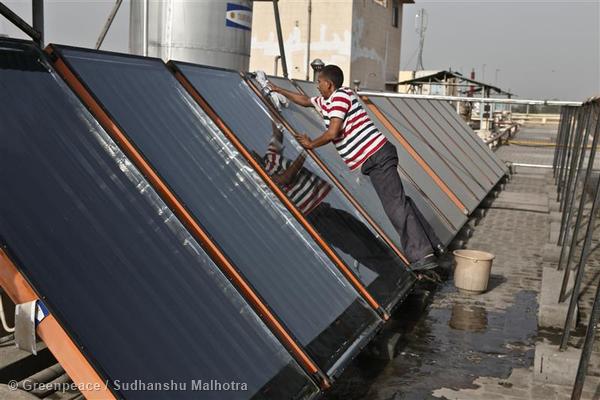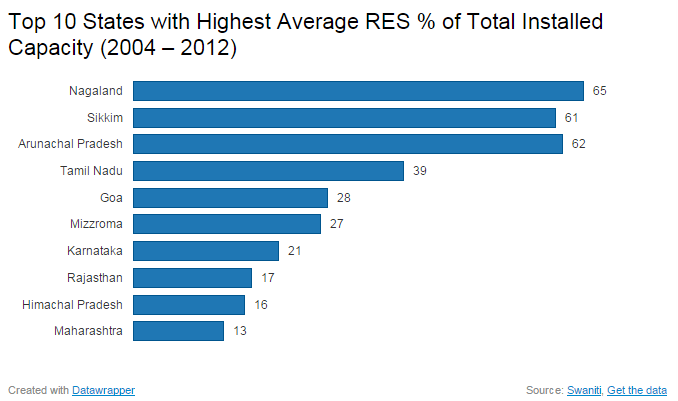Northeast India’s largest solar power plant began generating power last month in Tripura state, bringing the state government a step closer to achieving ambitious plans to turn the state capital Agartala into a solar city.
The 5 MW Monarchak plant is run by the North Eastern Electric Power Corporation (NEEPCO) and solar hot water systems are to be set up in hotels, nursing homes, hostels, government guest houses, hospitals and shopping centres as part of the city’s solar master plan.
NEEPCO plans to generate at least 1,500 MW of power from renewable energy in the Northeast by 2020 under the United Nation’s Clean Development Mechanism (CDM) initiative. NEEPCO has plans for another 5 MW solar plant at Hojai-Lanka in Assam and a 2 MW windmill in northern Arunachal Pradesh.
As India dreams of becoming a ‘renewable superpower’ it will need to look to the northeastern states as models for innovation, implementation and commitment to achieving a greener grid.
The Northeast region of India comprises Meghalaya, Mizoram, Manipur, Nagaland, Sikkim, Tripura, Assam and Arunachal Pradesh states.
State-wide analysis by Swaniti Initiative recently revealed that renewable energy accounts for a much higher percentage of overall state installed capacity in India’s Northeastern states with Nagaland (65%), Sikkim (64%) and Arunachal Pradesh (62%) leading the pack.
In stark contrast, states like Jharkhand (0%), Odisha (1%), West Bengal (2%), Haryana (2%) have a very small share of renewable sources in their energy production mix. Since eastern states, especially Jharkhand and West Bengal, account for a major share of coal production in India, they account for the large portion of coal tax (charged at Rs 100 per tones of coal mined) paid to the National Clean Energy Fund (NCEF).
Some of the success of the Northeast states is down to their natural endowments– Sikkim and Arunachal Pradesh, for example, have the ideal mountain slopes and roaring rivers to generate hydropower.
But effective regulatory environments and private sector participation also play a crucial role. The Arunachal Pradesh government, for instance, instigated the Small Hydropower Policy, which promotes private participation through attractive incentives. Similarly, the government of Sikkim has adopted polices to attract public and private investment in renewable power.
Solar revolution
There are a wide array of interesting solar projects emerging from the Northeast. Last year, the Meghalaya government sanctioned Rs 25 crore ($4 million) for the installation of solar lights under the Green City Project (GCP).
Nagaland set up innovative solar powered water treatment units in three villages of the state capital in June 2013. The water treatment units now provide drinking water to 2,639 people the most water scare villages of Kohima district, funded by the Union Ministry of Drinking Water and Sanitation.
The Manipur Renewable Energy Development Agency has launched a solar thermal scheme, which aims to provide at least 10,000 solar heaters to the nine districts of the state over the next five years, under the Jawaharlal Nehru National Solar Energy Mission. Manipur suffers from acute power shortages, with the state power department supplying 80MW against a demand of 170MW. The solar heaters, with a capacity of 100 litres per day, will cost around Rs 25,000 each and 75% of costs are subsidised by the state and central government. Manipur was the first state to install solar heaters on such a large scale.
The government of Mizoram also provides subsidised solar equipment. The central and state governments, in collaboration with Zoram Electricity Development Agency (ZEDA), have brought welcome solar powered lamps and heaters to many remote villages.
Not all northeasterm states have embraced renewables. In Assam, renewable energy only makes up 3% of the state’s energy mix. Assam has less wind power potential to meet its power demand but the state’s solar power potential could be better exploited. The State has around 240 to 260 clear days every year and 4.4 to 5.6 KWh of solar power potential per square metre per day, The Energy Research Institute (TERI) estimates.
The Ministry of New and Renewable Energy is promoting the use of solar energy devices and systems in the region. During 2007-08, 750 solar home lighting systems, 50 solar street lighting systems and 500 solar lanterns were allocated to Assam. In addition, projects have also been sanctioned for electrification of 555 villages through solar energy systems.
Although over 2,000 villages in Assam, including those in Char areas, were identified by the government for coverage through renewable energy sources –no specific schemes have been proposed to provide solar energy systems in the remote villages of the state.
In 2009, India unveiled its US$19 billion national solar mission which aims to produce 20GW of solar power by 2022. Under the plan, the use of solar-powered equipment and applications will be compulsory in all government buildings, as well as hospitals and hotels. The country is gearing up to realise this goal. In January 2015, the Indian government significantly expanded its solar plans, targeting US$100 billion of investment and 100 GW of solar capacity by 2022.
The central government also took an important step last week to finance these ambitious plans, by doubling the tax on coal in the country’s annual budget.
After all, renewable energy is a remedy to multiple problems – it can augment existing power capacity, encourage local manufacturing, control emission levels,as well as support waste management. The Indian government’s Swachh Bharat (Clean India) campaign may also encourage renewable energy instead of thermal power.

